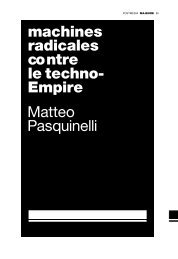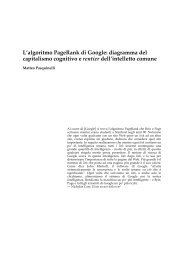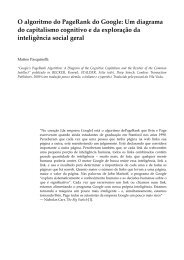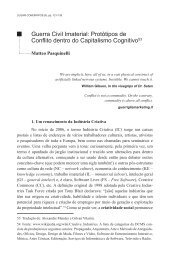Immaterial Civil War - Matteo Pasquinelli
Immaterial Civil War - Matteo Pasquinelli
Immaterial Civil War - Matteo Pasquinelli
You also want an ePaper? Increase the reach of your titles
YUMPU automatically turns print PDFs into web optimized ePapers that Google loves.
So far it seems a linear scenario, but there is also a grey zone to take inconsideration: the massification of the “creative” attitude. “Everyone is acreative” is a common slogan today. Many years after Benjamin’s artwork, themass artist enters the age of his social reproducibility and “creativity” is soldas a status symbol. The social base of Creative Industries is getting bigger (atleast in the Western world) and unveils new scenarios. In a first period,Creative Industries become hegemonic (as a fact and as an concept). In asecond one, they face an entropy of meaning and producers. Thanks to theinternet and the digital revolution, everyday we witness the conflicts of thelatter stage.All the different schools previously introduced focus each on a differentperspective. To clarify the subject we have to explode the question in itscomponents. The “creative thing” could be dismantled in: creative labour (asautonomous or dependent work), creativity as faculty and production, thecreative product (with all its layers: hardware, software, knoware, brand, etc.),the free reproducibility of the cognitive object, the intellectual property on theproduct itself, the social creativity behind it, the process of collectivevalorisation around it. Moreover, the social group of creative workers (the“creative class” or “cognitariat”), the “creative economy” and the “creativecity” represent further and broader contexts.The original definition of Creative Industries focus on the intellectualproperty exploitation. Richard Florida’s concepts of creative class and creativeeconomy are based on (controversial) statistics only and on the idea of apolitical agenda for CI fuelled by local governments. On another level,Creative Commons is about open licences, a formal solution to handle the freereproduction and sharing triggered by the digital revolution on a mass scale(“building a layer of reasonable copyright” 2 as they put it). Coming from adifferent (Latin) background, the post-Operaism and the precarious workersmovement point out the social and distributed form of production (Tronti’s“social factory” 3 ) and ask for a guaranteed minimum income. Geographicallyclose to the last ones, Enzo Rullani (initiator of the term ‘cognitive capitalism’)suggests to focus on the autonomous power of producers rather than on thedimension of dependent labour, as public welfare is a solution that transfersknowledge, risk and innovation capital to institutions. Such a disambiguationof political views around CI is needed to clarify what the present essay is notcovering. I will not focus on the labour conditions of (precarious) cognitiveworkers, on the exploitation of intellectual property an on the legal protectionof the public domain, but on the collective production of value and the strongcompetition cognitive producers face in the “immaterial” domain.4








